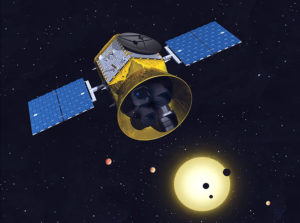TESS Mission
All posts tagged TESS Mission

Contrary to popular opinion, there are NOT 525,600 minutes in a year. That’s because the Earth takes more than 365 days to circle the Sun and come back to the same place (although defining “the same place” is non-trivial). Modern calendar systems assume 365.2422 days in a year, which works out to 525,948.768 minutes — it doesn’t quite roll off the tongue the same way, but it does give you almost 349 more seasons of love.
But that’s just for Earth. If you lived on one of the most recently discovered exoplanets, you would have fewer than a thousand love seasons. That’s because this planet, the ultra-hot Jupiter TOI-2109 b, circles its star once every 16 hours. But the fate of TOI-2109 b-ian lovers is sealed not just by their short seasons but because their planet is doomed, a sad destiny foretold by a French physicist who saw his own world rent to pieces.
Continue Reading
Daedalus’ situation was desperate: to keep the secret of the labyrinth, King Minos had trapped its creator, Daedalus, and his son Icarus in the maze with the man-eating Minotaur. In a fit of inspiration, Daedalus crafted two pairs of wings of feathers and wax. As they flew out over the Aegean Sea, Daedalus admonished Icarus not to fly too close to the Sun or else the wax holding the feathers would melt.
Famously full of flawed physics, this fabulous fable foreshadows the forbidding future for a planet newly discovered using data from NASA’s TESS Mission. Dubbed a “warm Jupiter”, TOI-3362 b swings around its host star every 18 days. Like Jupiter, it is a gas giant planet (with a mass five times greater than Jupiter’s), but, unlike Jupiter, It sweeps past its host star every 18 days on a wildly elongated orbit that flash-heats the planet. And like Icarus, TOI-3362 b will one day plunge disastrously into the sea (although in this case, it’s not the warm Aegean but a sea of molten plasma).
Continue Reading
Friday marked the end of the 2021 TESS Science Conference. Hosted virtually by MIT, this workshop marked the second in a series dedicated to exoplanet science related to NASA’s TESS (the Transiting Exoplanets Survey Satellite) mission. From the discovery of a gas giant on the verge of tumbling into its host star to observations of starquakes, the week was crammed too full for a single blog entry to do it justice.
So instead of a full summary, I wanted zero in on one topic that has profound implications for understanding the natures of exoplanets: the planets’ compositions.
Continue Reading
The TESS Spacecraft.
At our journal club last week, we discussed the discovery of a new warm Jupiter from the TESS Mission.
TESS is the successor to the wildly successful Kepler/K2 Mission and is designed to find exoplanets using the same technique as Kepler – looking for their shadows as planets pass in front of their host stars, i.e. the transit technique.
Sadly, the Kepler spacecraft was officially shut down two weeks ag0 because it ran out of fuel, but TESS, launched last March, is off and running, having already discovered about half a dozen new planets.
One of those planets, we discussed in journal club on Friday – a planet orbiting the star HD1397. The gas giant planet is about the same size as Jupiter but half the mass, making it significantly less dense than Saturn.
The planet also has an unusually eccentric or stretched-out orbit that swings very near its host star, passing to within 8 stellar radii from its star at its closest point. By contrast, the Earth is 200 stellar radii away from the Sun.
If this planet had been discovered 20 years ago, it would have completely stumped astrophysicists, and many would likely have doubted its existence. Nowadays, though, such strange planets are practically the norm in exoplanet astronomy.
So with HD1397 b’s discovery, the exoplanet train rumbles on, and we should expect thousands upon thousands more bizzarities from TESS that will, like Kepler’s discoveries, again re-write the planetary rulebook.
At our research group meeting, we also discussed the art of scientific presentations. I’ve pasted the example presentation I gave below.